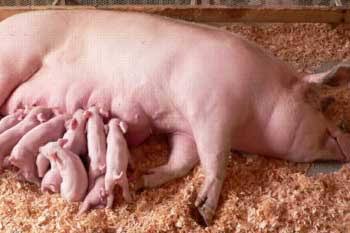Factors Affecting Litter Size in Sow
1. Genetics
Litter size and the percentage of large litters will continue to increase with the identification of genes affecting prolificacy, selection for prolificacy and the use of Chinese lines. There are large breed and genotype differences in litter size, however, the heritability of litter size is low (10 to 15%) so within-herd selection for litter size is unlikely to be beneficial. Selection for increased leanness and fast growth rate has not reduced litter size.
 Learn More
Learn More2. Ovulation rate and embryonic mortality
Ovulation rate sets the upper limit on litter size. Gilt selection on the basis of ovulation rate has not increased litter size because any increase in ovulation rate has been offset by an increase in embryo and fetal mortality. This mortality may be the result of a reduction in uterine space or blood supply per fetus.
3. Nutrition
The developing litter is given a very high priority for available energy and nutrients during pregnancy but, the requirement is very small. Therefore, under normal commercial conditions, it is unlikely that the feeding level during gestation will influence litter size. It has also been found that very high levels of vitamins do not increase litter size in herds using normal diets. Several experiments conducted at the University of Alberta have shown that severely restricted feed intake during any week of lactation will reduce ovulation rate and subsequent embryo survival.
Feeding gilts a good quality diet ad libitum for at least ten days prior to breeding will maximize ovulation rate and litter size but overfeeding gilts (greater than 2.5 kg feed/day) during the first 48 to 72 hours after breeding may reduce embryo survival.
READ ALSO: Gilt Management in Pig Farming
4. Service Management
Gilts and sows should be served 0 to 24 hrs (optimum 12 hrs) before ovulation to maximize litter size. In order to time breeding according to ovulation it is necessary to determine the average duration of estrus for gilts and sows and assume ovulation occurs at 70 percent of estrus.
Sexual maturity (number of cycles), at the time of service, has a greater influence on litter size than the age or weight of the gilt. Serving gilts at their second estrus rather than at puberty can increase litter size by about 0.7 pigs. Service with a vasectomized boar at the pubertal estrus followed by a fertile boar service at the second estrus may increase litter size by 0.7 pigs/litter. It has not been determined whether these effects are additive. A combination of natural service and AI, for gilts, may increase litter size compared to AI alone.
There is no difference in litter size between sows served by a boar or AI, assuming both are done properly. An increase in the percentage of sows returning to estrus on days six and seven after weaning will decrease farrowing rate and litter size. At least 85 percent of sows should return to estrus on days three, four, and five after weaning.
5. Boar Effects
Select prolific boars and do not overuse boars. Boar usage depends on need and the age of the boar. Young boars, 8-12 months of age, can be used for two to four consecutive services per week. Mature boars may be used for up to six services per week. High ambient temperature (30%C) will reduce boar fertility and subsequent litter size.
READ ALSO: Tips To Reduce Pig Feeding Costs
6. Management
All services, natural or AI, should be quality services. Group housing, where group size is large (greater than 20 animals) tends to cause a reduction in litter size, especially in gilts. Do not relocate sows prior to completion of implantation (in the first 28 days after service).
7. Lactation Length
There is a slight (0.06 pigs/day) decrease in litter size as lactation lengths decrease from 18 to 12 days. It appears that the negative effect of lactation length can be overcome by high daily feed intakes (greater than 5.6 kg/day). Lactation lengths of 18 to 28 days have very little effect on litter size.
8. Reproductive Diseases
Various diseases affect litter size and whether a sow farrows. The usual culprits are parvovirus or PRRS. These viruses can cross the placenta, infect the litter and cause embryo or fetal death. This may appear as a high mummy rate or a reduction in litter size, depending on whether or not mummies are detected. Questions regarding these diseases and possible vaccination schedules should be directed to the herd veterinarian.















